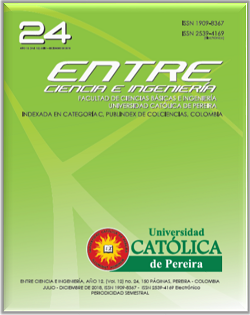Diseño estructural de un stent endovascular para el tratamiento de un aneurisma aórtico
DOI:
https://doi.org/10.31908/19098367.3809Palabras clave:
aneurisma, mecanismo ajustable, Stent endovascular, working modelResumen
Los actuales modelos de stents endovascularestienen un biomecanismo auto-expandible con memoria de formadel material, lo que en principio pretenden es un ajuste adecuadocon el medio de implantación arterial. Sin embargo, presentanalgunos problemas de desacoplamiento y de implantación enla arteria por diversas variabilidades biológicas. Como unaalternativa a estas situaciones, se desarrolló un modelo destent aórtico regulable (ajustable). Este modelo de movilidadcontrolada pretende facilitar el procedimiento de implantación yel no desacoplamiento por la actividad hemodinámica. Se elaboróun diseño geométrico y se desarrollaron diversas simulacionespara analizar su comportamiento biomecánico utilizando comoherramienta computacional el programa Working Model. Seobtuvieron unos resultados que indicaron la viabilidad y correctafuncionalidad de esta alternativa para el problema del desacoplee implantación.
Referencias
Kent, A. C., Zwolak, R. M., Egorova, N. N., Riles, T. S., Manganaro, A., Moskowitz, A. J., Gelijns, A. C., and Greco, G. “Analysis of riskfactors for abdominal aortic aneurysm in a cohort of more than 3million individuals,” J. Vasc. Surg., vol. 52, no. 3, pp. 539–548, 2010
Salazar S., M. E., Carballo F., C., Romero C., F., Giraldo M., J. P.,Arias M., Y. and Abu-Suboh A., A. Endofugas o Endoleaks enPrótesis Endovasculares de Aneurismas de Aorta Abdominal: Lo queel Radiólogo debe saber en relación al Diagnóstico, Caracterización yPrincipios Básicos de Manejo. Congreso SERAM 2012.DOI: http://dx.doi.org/10.1594/seram2012/S-1294
Serra P., A., Guardiola, F. M. and Montilla, B. V. “Novedades en stentsfarmacoactivos. Actualización y futuros desarrollos,” Rev. EspañolaCardiol. Supl., vol. 10, no. SUPPL. 3, p. 2C–11C, Jan. 2010.
Mertens, R., Valdés, F. and Krämer, A. “Tratamiento Endovascular delAneurisma de Aorta,” Revista Medica de Chile vol. 131, no. 6 1, pp.3–11, 2003. dx.doi.org/10.4067/S0034-98872003000600005
Hsiao, H. M., Chiu, Y. H., Lee, K. H. and Lin, C. H. “Computationalmodeling of effects of intravascular stent design on key mechanicaland hemodynamic behavior,” CAD Comput. Aided Des., vol. 44, no.8, pp. 757–765, 2012
Cambria, R.P., Brewster, D. C., Lauterbach, S. R., Kaufman, J. L.,Geller, S., Fan, C.M., Greenfield, A., Hilgenberg, A.and Clouse, W. D.“Evolving experience with thoracic aortic stent graft repair,” J. Vasc.Surg., vol. 35, no. 6, pp. 1129–1136, 2002.
Cox, G. S., O’Hara, P. J., Hertzer, N. R., Piedmonte, M. R., Krajewski,L. P. and Beven, E. G. “Thoracoabdominal aneurysm repair: Arepresentative experience,” J. Vasc. Surg., vol. 15, no. 5, pp. 780–788,1992
Stanley C., E., Crawford, J. L., Safi, H. J., Coselli, J. S., Hess, K. R.,Brooks, B., Norton, H. J. and Glaeser, D. H. “Thoracoabdominalaortic aneurysms: Preoperative and intraoperative factors determiningimmediate and long-term results of operations in 605 patients,” J.Vasc. Surg., vol. 3, no. 3, pp. 389–404, Mar. 1986
Dake, M. D., Miller, D. C., Mitchell, R. S., Semba, C. P., Moore, K. A.and Sakai, T. “The ‘first generation’ of endovascular stent-grafts forpatients with aneurysms of the descending thoracic aorta,” J. Thorac.Cardiovasc. Surg., vol. 116, no. 5, pp. 689–704, 1998
Dumoulin, C. and Cochelin, B. “Mechanical behaviour modelling ofballoon-expandable stents,” J. Biomech., vol. 33, no. 11, pp. 1461–1470, 2000.
Greenberg, R., Resch, T., Nyman, U., Lindh, M., Brunkwall, J.,Brunkwall, P., Malina, M., Koul, B., Lindblad, B. and Ivancev, K.“Endovascular repair of descending thoracic aortic aneurysms: anearly experience with intermediate-term follow-up,” J. Vasc. Surg.,vol. 31, no. 1, pp. 147–156, 2000.
Parodi, J. C., Palmaz, J. C. and Barone, H. D. “TransfemoralIntraluminal Graft Implantation for Abdominal Aortic Aneurysms,”Ann. Vasc. Surg., vol. 5, no. 6, pp. 491–499, Nov. 1991.
Semba, C. P., Kato, N., Kee, S.T., Lee, G. K., Mitchell, R. S., Miller,D. C. and Dake, M. D. “Acute Rupture of the Descending ThoracicAorta: Repair with Use of Endovascular Stent-Grafts,” J. Vasc. Interv.Radiol., vol. 8, no. 3, pp. 337–342, May 1997.
Thompson, C. S., Gaxotte, V. D., Rodríguez, J. A., Ramaiah, V.G., Vranic, M., Ravi, R., DiMugno, L., Shafique, S., Olsen, D. andDiethrich, E. B. “Endoluminal stent grafting of the thoracic aorta:Initial experience with the Gore Excluder,” J. Vasc. Surg., vol. 35, no.6, pp. 1163–1170, 2002.
De Bock, S., Iannaccone, F., De Santis, G., De Beule, M, Mortier, P.,Verhegghe, B. and Segers, P. “Our capricious vessels: The influenceof stent design and vessel geometry on the mechanics of intracranialaneurysm stent deployment,” J. Biomech., vol. 45, no. 8, pp. 1353–1359, 2012.
Kumar, G. P., Cui, F., Phang, H. Q., Su, B., Leo, H. L. and Hon, J.K. F. “Design considerations and quantitative assessment for thedevelopment of percutaneous mitral valve stent,” Med. Eng. Phys.,vol. 36, no. 7, pp. 882–888, 2014.
Azaouzi, M., Makradi, M. and Belouettar, S. “Numerical investigationsof the structural behavior of a balloon expandable stent design usingfinite element method,” Comput. Mater. Sci., vol. 72, pp. 54–61, 2013.
Hara, H., Nakamura, M., Palmaz, J. C. and Schwartz, R. S. “Role ofstent design and coatings on restenosis and thrombosis,” Adv. DrugDeliv. Rev., vol. 58, no. 3, pp. 377–386, 2006.
Erbel, R. and Eggebrecht, H. “Aortic dimensions and the risk of dissection.,” Heart, vol. 92, no. 1, pp. 137–42, Jan. 2006.
Sandgren, T., Sonesson, B., Ahlgren, A. R. and Länne, T. “Thediameter of the common femoral artery in healthy human: Influenceof sex, age, and body size,” J. Vasc. Surg., vol. 29, no. 3, pp. 503–510,1999.
Bernardi C. “Angiología e cirurgía vascular”. [En línea]. Disponibleen:https://cirurgia-vascular.com/aneurismas/ [Accedido: 30-may-2018].
“Waku Planet”. [En línea]. Disponible en: http://wakuplanet.com/580-rejilla-ajustable-para-ventanas.html [Accedido: 30-may-2018].
“Colegio Argentino de Cardioangiólogos intervencionistas”. [Enlínea]. Disponible en:http://caci.org.ar/post/stents [Accedido: 30-may-2018].
Suárez, G. y Bustamante, J. “Diseño y desarrollo de un nuevo anillo desoporte para bioprótesis valvular cardíaca porcina y/o humana”. Conf.Gaceta Cardiovascular ISSN:0124-7247 ed: Clínica cardiovascularSanta María, Colombia, 2001, v. fasc. pp. 2-2.




 <
<


 Revista Entre Ciencia e Ingeniería
Revista Entre Ciencia e Ingeniería .png) entrecei@ucp.edu.co
entrecei@ucp.edu.co.png) ISSN (Impreso) 1909-8367 - ISSN (En Línea) 2539-4169
ISSN (Impreso) 1909-8367 - ISSN (En Línea) 2539-4169 Attribution-NonCommercial 4.0 International (CC By-NC 4.0)
Attribution-NonCommercial 4.0 International (CC By-NC 4.0)
.png) Carrera 21 No. 49-95 Av. de las Américas, Pereira, Risaralda, Colombia
Carrera 21 No. 49-95 Av. de las Américas, Pereira, Risaralda, Colombia